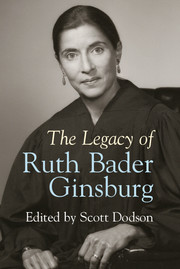Book contents
- Frontmatter
- Contents
- Contributors
- Preface
- Acknowledgments
- Part I Shaping a Legacy
- Part II Rights and Remedies
- Part III Structuralism
- Part IV The Jurist
- 13 Reflections on the Confirmation Journey of Ruth Bader Ginsburg, Summer 1993
- 14 Justice Ginsburg
- 15 Oral Argument as a Bridge between the Briefs and the Court’s Opinion
- 16 Fire and Ice
- Coda
- Notes
- Index
16 - Fire and Ice
Ruth Bader Ginsburg, the Least Likely Firebrand
Published online by Cambridge University Press: 05 February 2015
- Frontmatter
- Contents
- Contributors
- Preface
- Acknowledgments
- Part I Shaping a Legacy
- Part II Rights and Remedies
- Part III Structuralism
- Part IV The Jurist
- 13 Reflections on the Confirmation Journey of Ruth Bader Ginsburg, Summer 1993
- 14 Justice Ginsburg
- 15 Oral Argument as a Bridge between the Briefs and the Court’s Opinion
- 16 Fire and Ice
- Coda
- Notes
- Index
Summary
Ruth Bader Ginsburg is so frequently referred to as the “Thurgood Marshall of Women’s Rights” that it’s nearly become a legal cliché. And in some sense the comparison is perfectly appropriate: as head and founder of the ACLU’s Women’s Rights Project, Ginsburg devised and oversaw a brilliant and subtle litigation strategy that achieved – in just a few short years – extraordinary outcomes for women’s equality under the law. Unsurprisingly, she modeled much of the legal work and analysis on the blueprint laid out by Marshall in his tenure at the National Association for the Advancement of Colored People (NAACP). But visitors to oral argument at the Supreme Court – particularly those who grew up with a mental picture of Ginsburg as a kind of supercharged cross between Thurgood Marshall and Gloria Steinem – often remark that the soft-spoken, mild-mannered Ginsburg is nothing like the feminist firebrand they were expecting.
There’s something about her early advocacy work with the ACLU, and the inevitable comparisons to Marshall, that leads us to imagine Ginsburg as an outspoken ’70s era, bra-burning women’s libber. We might imagine a Justice Ginsburg who regales her judicial colleagues, as Marshall used to, with lengthy discursions about the injustices of her life back in the bad old pre-equality days, and one who pens searing opinions that channeled Susan B. Anthony. Yet the public encounters with the diminutive, soft-spoken Ginsburg are hard to reconcile with that image. Even when she was an ACLU litigator, Ginsburg was quiet and scholarly, even if the injustices she worked to correct were deeply felt and personally resonant. And that is why the truth about Ginsburg is far more compelling: the realities of her early life, the nature of her legal project, and her own precise, understated temperament have combined to make her appear more Ninja Librarian than Raging Gender Warrior. Ginsburg is indeed a feminist firebrand, but she is, both by choice and necessity, a firebrand made of ice.
- Type
- Chapter
- Information
- The Legacy of Ruth Bader Ginsburg , pp. 222 - 232Publisher: Cambridge University PressPrint publication year: 2015

